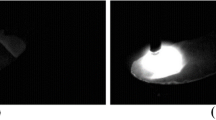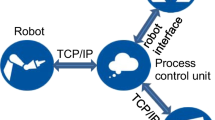Abstract
The real-time detection of the state of the gap and weld penetration control are two fundamental issues in robotic arc welding. However, traditional robotic arc welding lacks external information feedback and the function of real-time adjusting. The objective of this research is to adopt new sensing techniques and artificial intelligence to ensure the stability of the welding process through controlling penetration depth and weld pool geometry. A novel arc welding robot system including function modules (visual modules, data acquisition modules) and corresponding software system was developed. Thus, the autonomy and intelligence of the arc welding robot system is realized. Aimed at solving welding penetration depth, a neural network (NN) model is developed to calculate the full penetration state, which is specified by the back-side bead width (Wb), from the top-side vision sensing technique. And then, a versatile algorithm developed to provide robust real-time processing of images for use with a vision-based computer control system is discussed. To this end, the peak current self adaptive regulating controller with weld gap compensation was designed in the robotic arc welding control system. Using this closed-loop control experiments have been conducted to verify the effectiveness of the proposed control system for the robotic arc welding process. The results show that the standard error of the Wb is 0.124 regardless of the variations in the state of the gap.
Similar content being viewed by others
Explore related subjects
Discover the latest articles, news and stories from top researchers in related subjects.References
Tsai, C.-H., et al.: Fuzzy control of pulsed GTA welds by using real-time root bead image feedback. J. Mater. Process. Technol. 176, 158–167 (2006). doi:10.1016/j.jmatprotec.2006.02.027
Luo, H.: Robotic welding, intelligence and automation, laser visual sensing and process control in robotic arc welding of titanium alloys. LNCIS 299, 110–122 (2004)
Valavanis, K.P., Saridis, G.N.: Intelligent Robotics System: Theory, Design and Applications, pp. 12–18. Boston (1992)
Miller, M., Mi, B., Kita, A., Ume, C.: Development of automated real-time data acquisition system for robotic weld quality monitoring. Mechatronics 12, 1259–1269 (2002). doi:10.1016/S0957-4158(02)00028-4
Song, H.S., Zhang, Y.M.: Measurement and analysis of three-dimensional specular gas tungsten arc weld pool surface. Weld. J. 87(4), 85–95s (2008)
Adolfsson, S., Bahrami, A., Bolomsjo, G., Cleason, I.: On-line quality monitoring in short-circuit gas metal arc welding. Weld. J. 78(2), 59–73s (1999)
Casalino, G., Hu, S.J., Hou, W.: Deformation prediction and quality evaluation of the gas metal arc welding butt weld. Proc. Inst. Mech. Eng., B J. Eng. Manuf. 217(11), 1615–1622 (2003)
Kovacevic, R., Zhang, Y.M.: Real-time image processing for monitoring of free weld pool surface. J. Manuf. Sci. Eng. 119(5), 161–169 (1997). doi:10.1115/1.2831091
Kovacevic, R., Zhang, Y.M., Li, L.: Monitoring of weld penetration based on weld pool geometrical appearance. Weld. J. 75(10), 317–328 (1996)
Lim, T.G., Cho, H.S.: Estimation of weld pool sizes in GMA welding process using neural networks. J. Syst. Control Eng. 207(1), 15–26 (1993)
Saeed, G., Zhang, Y.M., Jaynes, C.: Weld pool surface monitoring and depth extraction using a calibrated CCD sensor. In: ASM Proceedings of the International Conference: Trends in Welding Research, vol. 2005, pp. 665–670 (2005)
Bae, K.Y., Lee, T.H., Ahn, K.C.: An optical sensing system for seam tracking and weld pool control in gas metal arc welding of steel pipe. J. Mater. Process. Technol. 120(2), 458–465 (2002). doi:10.1016/S0924-0136(01)01216-X
Chen, S.B., Wu, L., Wang, Q.L.: Self-learning fuzzy neural networks for control of uncertain systems with time delay. IEEE Trans. Syst. Man Cybern., Part B, Cybern. 27(1), 142–148 (1997)
Chen, S.B., Chen, X.Z., Qiu, T., Li, J.Q.: Acquisition of weld seam dimensional position information for arc welding robot based on vision computing. J. Intell. Robot. Syst. 43, 77–97 (2005). doi:10.1007/s10846-005-2966-6
Akira, H., Yasuyoshi, K., et al.: Sensing and control of weld pool by fuzzy-neural network in robotic welding system. IECON’01.2001:238–242
Balfour, C., Smith, J.S, AI-Shamma, A.I.: A novel edge feature correlation algorithm for real-time computer vision-based molten weld pool measurements. Weld. J. 85(1), 1–8s (2006)
Kristinn, E., Cook, G.E.: Artificial neural networks applied to arc welding process modeling and control. IEEE Trans. Ind. Appl. 26(5), 824–830 (1990). doi:10.1109/28.60056
Juang, S.C., Tarng, Y.S.: A comparison between the back-propagation and counter-propagation networks in the modeling of the TIG welding process. J. Mater. Process. Technol. 75, 54–62 (1998) doi:10.1016/S0924-0136(97)00292-6
Mi, B.: Implementation of fiber phased array ultrasound generation system and signal analysis for weld penetration control. Doctoral Dissertation Georgia Institute of Technology, pp. 9–45, (2003)
Meer, P., Georgescu, B.: Edge detection with embedded confidence. IEEE Trans. PAMI 23(120), 1351–1365 (2001)
Song, P., Zuxiang, F.: The joint optimization of BP learning algorithm. J. Circuits Syst. 5(3), 26–30 (2000)
Wang, J.J., Lin, T., Chen, S.: Obtaining of weld pool vision information during aluminum alloy TIG Welding. Int. J. Adv. Manuf. Technol. 26, 219–227 (2005). doi:10.1007/s00170-003-1548-7
Author information
Authors and Affiliations
Corresponding author
Rights and permissions
About this article
Cite this article
Chen, H., Lv, F., Lin, T. et al. Closed-Loop Control of Robotic Arc Welding System with Full-penetration Monitoring. J Intell Robot Syst 56, 565 (2009). https://doi.org/10.1007/s10846-009-9329-7
Received:
Accepted:
Published:
DOI: https://doi.org/10.1007/s10846-009-9329-7




